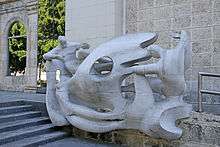Museo Nacional de Bellas Artes de La Habana
 | |
| Established | February 23, 1913 |
|---|---|
| Location | Palace of the Asturian Center - San Rafael, e/Zulueta y Monserrate, Old Havana, Havana, Cuba 10200 |
| Type | Fine Arts Museum |
| Website | www.museonacional.cult.cu |
The National Museum of Fine Arts of Havana (Museo Nacional de Bellas Artes de La Habana) in Havana, Cuba is a museum of Fine Arts that exhibits Cuban art collections from the colonial times up to contemporary generations.
History

It was founded on February 23, 1913 due to the efforts of its first director, Emilio Heredia, a well-known architect. After frequent moves it was finally placed on the block once occupied by the old Colon Market. In 1954, a new Palacio of Bellas Artes was opened, designed by the architect Rodriguez Pichardo. The original 1954 Palacio was recently reconstructed by the architect Jose Linares and a second building was taken over for the Museum.
Overview

There are now two impressive buildings belonging to the Museum, one dedicated to Cuban Arts in the Palacio de Bellas Artes (Palace of Fine Arts) and one dedicated to the Universal Arts, in the Palacio del Centro Asturiano (Palace of the Asturian Center).

The Palacio de Bellas Artes (Palace of Fine Arts) is dedicated exclusively to housing Cuba Art collections. Spanning the 17th and 19th centuries has rooms devoted to landscape, religious subjects and the Costumbrismo narrative scenes of Cuban life. Gallery devoted to the 1970s is marked by a preponderance of Hyperrealism and the latest generation of Cuban artists whose works all reflect the strong symbolic imagery that has been prevalent in recent decades. The most notable works are those of René Portocarrero and Wifredo Lam. A modernist sculpture by noted Cuban artist Rita Lonja stands outside the main entrance.
Other Cuban artists on display include Leopoldo Romañach, Víctor Manuel, Federico Beltrán Masses, Rafael Lillo, Jose A. Bencomo Mena, Manuel Vega, Domingo Ramos, Guillermo Collazo, Mariano Rodriguez, Carlos Enríquez Gómez, and Jorge Arche.
In the Palacio del Centro Asturiano (Palace of the Asturian Center) built in 1927 by the architect Manuel Bustos European paintings and sculptures, along with a collection of ancient art are on displayed there. Originally, it was a club for natives of the Spanish Province of Asturias and after the 1959 Revolution it housed the Supreme Court of Justice.
Address
- Palace of Fine Arts - Trocadero Street e/Zulueta y Monserrate, Old Havana, Havana, Cuba 10200
- Palace of the Asturian Center - San Rafael, e/Zulueta y Monserrate, Old Havana, Havana, Cuba 10200
See also
-
 Cuba portal
Cuba portal - List of museums in Cuba
References
- Cuba - Eyewitness Travel Guides (Dorling Kindersley Publishing, 2004) ISBN 0-7566-0172-X
- Moon Handbooks: Cuba' (Avalon Travel Publishing, 2007) ISBN 1-56691-802-2
- The Odyssey Illustrated Guide To Cuba (Guidebook Company Ltd., 1995) ISBN 962-217-370-5
External links
Coordinates: 23°8′24.8″N 82°21′25.9″W / 23.140222°N 82.357194°W